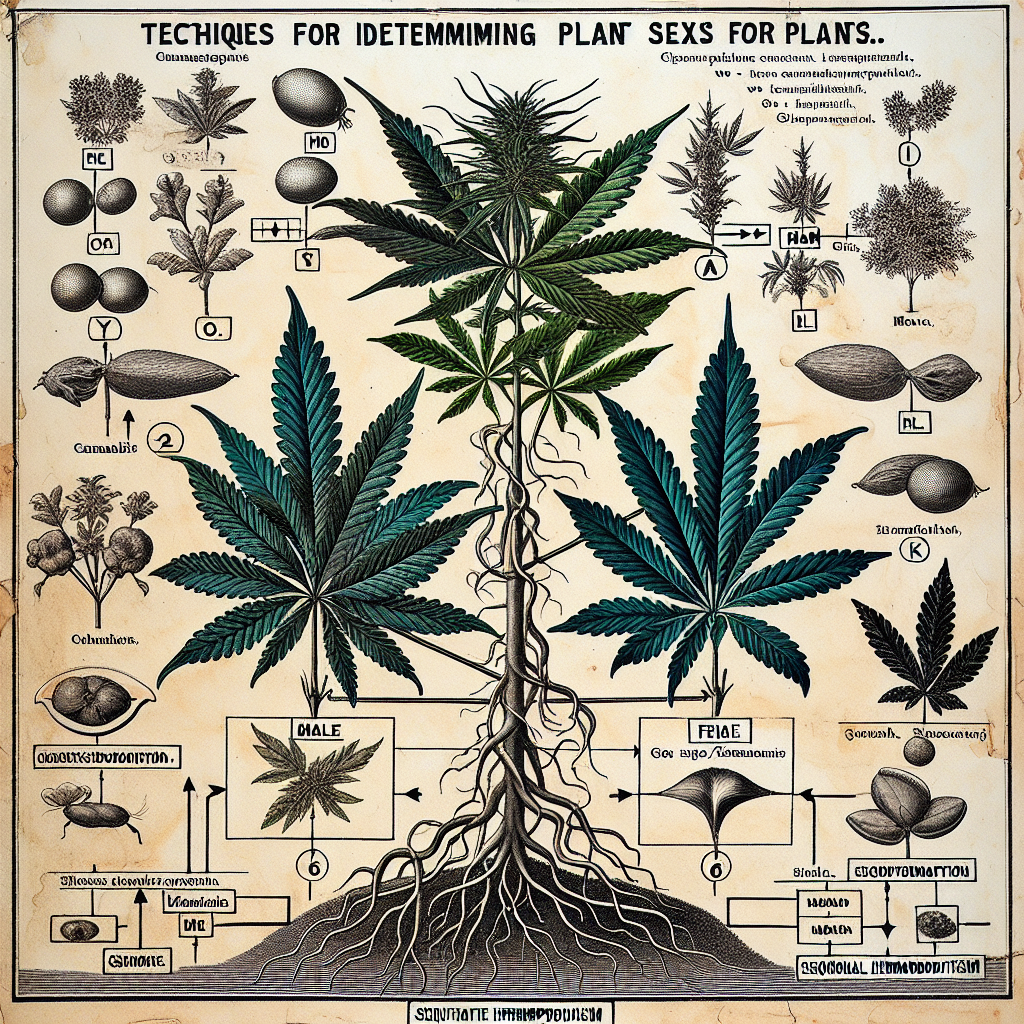Determining Cannabis Plant Sex

Determining Cannabis Plant Sex. Have you ever wondered how cannabis growers are able to determine the sex of their plants? In the world of cannabis cultivation, being able to identify whether a plant is male or female is crucial. Knowing the sex of the plant allows growers to separate them and ensure the best possible yield. In this article, we will explore the various methods used by growers to determine cannabis plant sex, from the subtle signs to more scientific approaches. So, whether you’re a seasoned grower or just curious about the fascinating world of cannabis cultivation, let’s dive into the ways to determine cannabis plant sex.
Why is it important to determine cannabis plant sex?
Determining the sex of cannabis plants is crucial for several reasons. It impacts cultivation, yield, potency, and even legal considerations. Understanding the sex of your plants allows you to implement appropriate cultivation techniques, optimize your yield, and ensure compliance with local laws and regulations. So, let’s dive deeper into each of these aspects.
Effect on cultivation
Cannabis cultivation requires careful planning and attention to detail. Determining the plant’s sex is crucial in this process. Male and female plants have different growth patterns, and their needs vary significantly. By identifying the sex early on, you can provide the right conditions and ensure optimal growth.
Knowing the sex of your cannabis plants allows you to allocate resources efficiently. Male plants, for example, do not produce buds with high THC content, making them less desirable for most cultivators. By identifying and removing male plants early, you can channel your resources towards maximizing the growth of female plants, which produce the resinous buds sought-after by cannabis enthusiasts.
Effect on yield
Sex determination plays an essential role in maximizing the yield of your cannabis plants. Female plants are the main focus for most growers as they produce the prized flowers or buds rich in cannabinoids. By identifying and removing male plants, you prevent their pollen from fertilizing female plants. Fertilization can reduce the quality and quantity of the buds produced, resulting in lower yields.
Taking the time to determine the sex of your cannabis plants allows you to focus your efforts on growing bigger, denser buds. This, in turn, leads to higher overall yields and maximizes the return on your investment of time, energy, and resources.
Effect on potency
Cannabis potency is largely determined by the presence of cannabinoids, such as THC and CBD. Female cannabis plants tend to produce higher levels of these compounds compared to males. By identifying and removing male plants, you can ensure that the female plants receive the necessary resources to develop potent buds with high cannabinoid content.
Determining the sex of your cannabis plants enables you to curate strains with specific potency profiles. Whether you are growing cannabis for medicinal or recreational purposes, understanding the sex of your plants helps you tailor your cultivation practices to achieve the desired potency.
Legal considerations
Legal regulations surrounding cannabis cultivation and possession vary widely around the world. In many jurisdictions, the cultivation of cannabis for personal use or commercial purposes is strictly regulated or entirely prohibited. Determining the sex of your plants helps you comply with these laws.
In some cases, growing cannabis without a license may result in significant legal consequences. Identifying and removing male plants can help prevent accidental pollination and ensure compliance with regulations aimed at preventing the spread of cannabis beyond authorized cultivation sites.
Methods to determine cannabis plant sex
There are several methods available to determine the sex of cannabis plants, each with its advantages and limitations. Let’s explore these methods in further detail:
Visual inspection
Visual inspection is one of the most straightforward methods to determine cannabis plant sex. It involves observing the physical characteristics and differences between male and female plants.
Differences between male and female plants: Male cannabis plants tend to be taller and have thicker stalks. They often develop pollen sacs or “balls” around six weeks into the vegetative stage. Female plants, on the other hand, have distinct stigma or hair-like structures that develop into buds. They may also display calyx structures, which are the base for future buds.
Identification of male plants: Male plants typically exhibit elongated, pendulous structures called stamens within their pollen sacs. These sacs resemble small bunches of grapes and can be found in the joints where branches and leaves meet the main stem.
Identification of female plants: Female cannabis plants produce pre-flower structures called pistils, which develop into buds over time. Pistils are hair-like structures emerging from the calyx and are often sticky to the touch. Female plants may also display a larger number of branches and leaves compared to male plants.
Pre-flowers
Pre-flowers are an early indicator of the sex of cannabis plants and can be identified before the plants reach full maturity. This method requires a keen eye and some experience, but it is a useful tool for early plant selection and resource allocation.
Definition and appearance: Pre-flowers are essentially the sexual organs of cannabis plants that develop during the vegetative stage. They provide a glimpse into the plant’s future sex, allowing for early decision-making in cultivation.
Timing for pre-flower identification: Pre-flowers usually become visible around four to six weeks into the vegetative stage, depending on the strain and growing conditions. It is essential to identify them early to implement appropriate cultivation practices promptly.
Identifying male pre-flowers: Male pre-flowers are characterized by small, round bracts that contain no pistils. These bracts typically cluster in the crotch between branches and the main stem. Identifying and removing male plants at this stage can prevent pollination and preserve the quality of female plants.
Identifying female pre-flowers: Female pre-flowers can be identified by the presence of small, translucent hair-like structures called pistils. These pistils emerge from the calyx, indicating the potential for bud development. Identifying and nurturing female plants at this stage is key to maximizing yields and potency.
DNA testing
DNA testing provides a highly accurate and scientific method for determining the sex of cannabis plants. It utilizes genetic analysis to identify the presence of male or female chromosomes. While DNA testing is not commonly used by individual cultivators due to its cost and technicality, it is a valuable tool for larger-scale operations and breeders.
Overview of DNA testing: DNA testing involves collecting a sample from the plant and sending it to a specialized laboratory for analysis. The lab examines the plant’s genetic material to identify specific genes or chromosomes associated with male or female traits.
Pros and cons: DNA testing offers high accuracy and early sex determination. It is particularly useful for breeders who need to select specific genotypes for hybridization or feminized seed production. However, it is more expensive and time-consuming compared to other methods, often requiring professional assistance.
Types of DNA testing: Different types of DNA testing can be used to determine cannabis plant sex, including polymerase chain reaction (PCR) and fluorescent in situ hybridization (FISH). PCR-based tests amplify specific DNA sequences, while FISH uses fluorescently labeled probes to bind to target chromosomes.
Reliability and accuracy: DNA testing is considered highly reliable and accurate, with minimal room for error. It provides definitive results, ensuring the selection of female or male plants as desired. However, it is essential to use a reputable laboratory and follow proper sampling and testing protocols to ensure reliable outcomes.
Hormonal treatment
Hormonal treatment offers a unique method to influence the sex of cannabis plants. By manipulating the plant’s hormones, growers can control the expression of male and female traits. However, hormonal treatment is not recommended for inexperienced cultivators, as it requires extensive knowledge and careful attention.
Purpose of hormonal treatment: Hormonal treatment aims to induce the production of male or female flowers on cannabis plants that would typically be hermaphroditic or have an undetermined sex. It provides a way to cultivate only female plants or produce feminized seeds, eliminating the risk of accidental pollination.
Common hormonal treatments: Ethephon, silver thiosulfate, and silver nitrate are commonly used hormonal treatments in cannabis cultivation. These substances interfere with the plant’s natural hormone balance, encouraging the development of male or female flowers.
Effectiveness and limitations: Hormonal treatment can be effective in producing desired results, such as generating all-female crops or feminized seeds. However, it requires precise timing, dosage, and application methods. Improper use can have adverse effects on plant health, productivity, and genetic stability.
Safety considerations: Hormonal treatments involve the use of chemical substances that can be hazardous if mishandled. It is crucial to follow safety guidelines, wear appropriate protective gear, and dispose of any unused or expired substances properly. Inexperienced cultivators should seek guidance from experienced growers or horticultural professionals before attempting hormonal treatment.
Environmental factors
Environmental factors can influence the sex expression of cannabis plants. While they do not offer a foolproof method to determine plant sex, understanding their impact allows growers to manipulate conditions to favor certain sexes.
Impact of factors on plant sex: Temperature, lighting, and nutrition are known to influence the sex expression of cannabis plants. By adjusting these factors, growers can shift the odds in favor of producing more female or male plants.
Temperature: Temperature plays a crucial role in determining the sex of cannabis plants. Higher temperatures during the cultivation period can promote the development of female flowers. Lower temperatures can increase the chances of male flower production.
Lighting: Light cycles and intensity affect the sex expression of cannabis plants. For example, female flowers tend to form under longer dark periods compared to male flowers. Manipulating the light cycle can help encourage the desired sex expression.
Nutrition: Adequate and balanced nutrition is essential for healthy plant growth. Nutrient deficiencies or imbalances can lead to stress and increase the likelihood of hermaphroditism. Providing optimal nutrition to cannabis plants promotes overall health and reduces the risk of unwanted sex expression.

Practical implications of determining cannabis plant sex
Determining the sex of cannabis plants has practical implications that extend beyond basic cultivation practices. Let’s explore some of these implications further:
Breeding and hybridization
Determining the sex of cannabis plants is vital for breeders and those interested in hybridization. By selecting plants with desired traits and known sexes, breeders can create offspring with specific characteristics. This process helps develop new strains with unique cannabinoid profiles, flavors, and growth patterns.
Knowing the sex of parent plants also ensures controlled and intentional breeding, preventing accidental cross-pollination that can compromise genetic stability and quality.
Seed production
Determining the sex of cannabis plants is crucial for seed production. To create feminized seeds, where all offspring are female, it is essential to eliminate the possibility of male plants in the seed production process. This requires accurately determining the sex of parent plants and implementing appropriate cultivation techniques to prevent pollination.
The ability to produce feminized seeds also provides commercial opportunities for both seed banks and cultivators looking to produce their own seeds in a controlled and efficient manner.
Cultivation techniques
Determining the sex of cannabis plants allows cultivators to tailor their cultivation techniques for optimal growth and yield. By eliminating male plants, which do not produce desirable buds, growers can allocate resources more efficiently towards the female plants. This includes providing specific nutrients, pruning techniques, trellising methods, and training to maximize bud development and overall yield.
Understanding the sex of plants also enables growers to manage their cultivation space more effectively, adjusting plant spacing and training techniques to accommodate different growth patterns.
Harvesting considerations
Determining the sex of cannabis plants plays a vital role in harvesting considerations. Female plants are generally harvested later than males to maximize cannabinoid production and resin development. By accurately identifying male plants, growers can plan their harvest schedule accordingly and ensure all plants reach their peak potency before harvesting.
Proper sex determination also reduces the likelihood of harvesting non-bud material and allows growers to focus their harvesting efforts on the plants that will yield the highest-quality buds.
Challenges and limitations
While determining cannabis plant sex is critical, there are challenges and limitations associated with the process. It is essential to be aware of these factors to make informed decisions and mitigate potential issues.
Inaccurate identification
Accurately identifying the sex of cannabis plants can be challenging, especially for beginners. Visual inspection and pre-flower identification require experience and an understanding of plant anatomy. Mistakes in sex determination can lead to significant cultivation complications, such as accidental pollination, reduced yields, or compromised genetic stability.
Hermaphroditism
Hermaphroditism, the development of both male and female sexual organs in a single plant, is another challenge in cannabis cultivation. Environmental stress, genetic predisposition, or other factors can trigger hermaphroditism in plants, leading to unwanted seed production and reduced bud quality.
To mitigate the risk of hermaphroditism, it is essential to maintain a stable growing environment, provide optimal nutrition, and select genetically stable strains for cultivation.
Complexity of environmental factors
Manipulating environmental factors to influence plant sex can be challenging, as multiple factors are interconnected. Temperature, lighting, and nutrition are interdependent and require careful balancing to achieve desired sex expressions. It may take time and experimentation to fine-tune these conditions for consistent results.
It is crucial to monitor environmental factors regularly and maintain stable conditions throughout the crop cycle to minimize the risk of unintended sex expression.

Conclusion Determining Cannabis Plant Sex
Determining the sex of cannabis plants plays a significant role in successful cultivation. It impacts various aspects, including cultivation techniques, yield, potency, and legal considerations. Visual inspection, pre-flower identification, DNA testing, hormonal treatment, and manipulation of environmental factors are methods used to determine plant sex.
Each method has its advantages and limitations, and growers must choose the approach that aligns with their goals, resources, and expertise. By accurately determining and managing plant sex, cultivators can optimize their cultivation practices, maximize yields, and produce higher-quality buds. Additionally, understanding the sex of plants opens doors to breeding, seed production, and controlled hybridization, contributing to the advancement and diversification of the cannabis industry.



